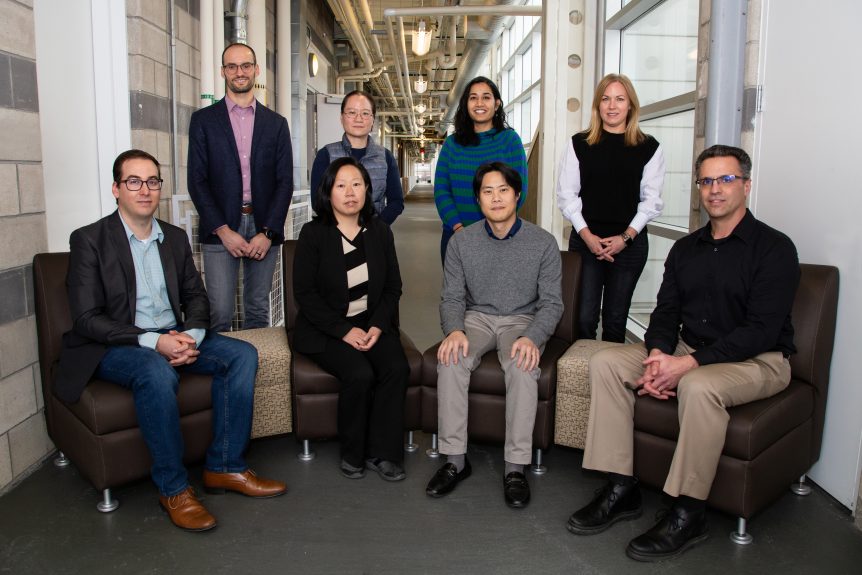Photo: Ohio State News — Front row (l to r): Jose Lorie Lopez (postdoc), Anne Co, Jung Hyun, Jay Sayre. Back row: Marcello, Qingmin Xu (IMR Research Scientist), Navni Verma (IMR Research Engineer), Kari Roth (IMR Innovation Manager).
Funding will support the development of more affordable and efficient electric vehicle batteries in America
The Department of Energy recently announced that The Ohio State University has been awarded a $3,876,363 grant from the Department of Energy (DOE) Electric Vehicles for American Low-Carbon Living (EVs4ALL) program.
The university is one of 12 teams from universities, national laboratories and the private sector to address and remove key technology barriers to EV adoption by developing next-generation battery technologies.
Ohio State collaborators include Honda, Mechanical and Aerospace Engineering Professor Marcello Canova and Assistant Professor Jung Hyun Kim, leveraging resources and staff at the Center for Automotive Research and the Institute for Materials Research. The technology-to-market team will be led by Professor Jay Sayre, assistant vice president in the Office of Research and the director of innovation for the Institute for Materials Research.
“The U.S. Department of Energy’s grant is an exciting investment in the future of clean energy and a testament to the dedicated Ohio State researchers who are working at the forefront of more affordable, sustainable and accessible transportation,” said Melissa Gilliam, executive vice president and provost. “I am delighted to see those efforts recognized with this funding that will accelerate electric vehicle adoption.”
Most of today’s electric vehicles (EV) can achieve driving range comparable to gas-powered vehicles, while the fastest charging times are a far cry from the five minutes to fill a gas tank. The ability to produce affordable, reliable and safe EVs with the convenience created by rapid charging could alleviate barriers to EV adoption among a larger percentage of the population.
In response to the challenges in promoting mass adoption of EVs, Ohio State developed a prototype high-power battery technology that can tolerate rapid charging while exhibiting longevity far beyond the current state-of-the-art lithium-ion cells.
“Collaboration is essential for the creation of innovative technology,” said Anne Co, professor in the Department of Chemistry and Biochemistry. “It is as exciting as it is rewarding to work alongside colleagues and industry partners who are working together to find effective and affordable solutions that will advance science and preserve our environment.”
In partnership with the Honda and Argonne National Laboratory, Ohio State will scale the high-power battery prototype by (1) addressing manufacturing challenges in achieving large-format, commercial-quality cells, (2) allowing for drop-in compatibility with existing battery components and (3) optimizing battery performance for cold temperatures. The technology can potentially double the usable battery lifetime, reduce pack size, decrease cell and battery cost, and enable rapid charging, which will help to accelerate the introduction of affordable entry-level electric vehicles.
EVs4ALL aims to expand domestic EV adoption by developing batteries that last longer, charge faster, perform efficiently in freezing temperatures and have better overall range retention. The program is managed by DOE’s Advanced Research Projects Agency-Energy (ARPA-E). Electrifying the transportation sector is critical to rapidly decarbonizing the American economy and eliminating heavy-emitting industries.
DOE is directly supporting President Biden’s goals to develop advanced technologies in America that will power the clean energy transition globally and for EVs to make up half of all domestic vehicle sales in 2030. The Ohio State battery technology is based on abundant, inexpensive materials, which exhibit exceptional longevity under extreme fast-charging scenarios, and is essential to achieving the vision of affordable, resilient EVs for all.
Ohio State has a track record of ARPA-E funding success. Most recently, a research team led by Electrical and Computer Engineering Associate Professor Julia Zhang received more than $2.4 million to transform the design and manufacturing processes of electric machines for electrified vehicles. In 2021, a team including Canova earned $5 million in funding from ARPA-E’s Next-Generation Energy Technologies for Connected and Automated On-Road Vehicles (NEXTCAR) program to optimize fuel economy in light-duty vehicles.
“We are excited to be included among the teams imagining revolutionary transformations of electric vehicles; it’s another example of the power of Ohio State collaborations,” said David Horn, dean of the College of Arts and Sciences. “This breakthrough research in EV batteries is pointing us toward a more responsible and sustainable future.”

